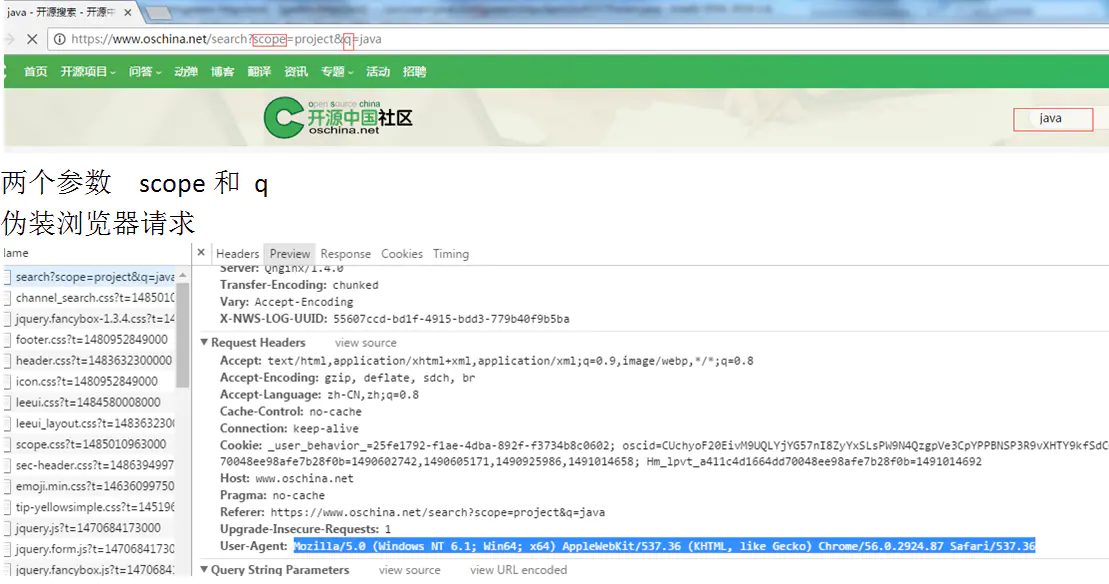# HttpClient使用详解与实战一:普通的GET和POST请求
# 简介
HttpClient是Apache Jakarta Common下的子项目,用来提供高效的、最新的、功能丰富的支持HTTP协议的客户端编程工具包,并且它支持HTTP协议最新的版本和建议。
HttpClient最新版本是HttpClient 4.5.3 (GA)。
官方下载:[http://hc.apache.org/downloads.cgi](https://link.jianshu.com/?t=http://hc.apache.org/downloads.cgi)
# 主要特性
* 基于标准、纯净的Java语言,实现了HTTP1.0和HTTP1.1。
* 以可扩展的面向对象的结构实现了HTTP全部的方法(GET, POST, PUT, DELETE, HEAD, OPTIONS, and TRACE)。
* 支持加密的HTTPS协议(HTTP通过SSL协议)。
* 通过HTTP代理方式建立透明的连接。
* 利用CONNECT方法通过HTTP代理建立隧道的HTTPS连接。
* Basic, Digest, NTLMv1, NTLMv2, NTLM2 Session, SNPNEGO/Kerberos认证方案。
* 插件式的自定义认证方案。
* 可插拔的安全套接字工厂,使得接入第三方解决方案变得更容易
* 连接管理支持使用多线程的的应用。支持设置最大连接数,同时支持设置每个主机的最大连接数,发现并关闭过期的连接。
* 自动化处理Set-Cookie:来自服务器的头,并在适当的时候将它们发送回cookie。
* 可以自定义Cookie策略的插件化机制。
* Request的输出流可以避免流中内容体直接从socket缓冲到服务器。
* Response的输入流可以有效的从socket服务器直接读取相应内容。
* 在HTTP1.0和HTTP1.1中使用用KeepAlive来保持持久连接。
* 可以直接获取服务器发送的响应码和响应头部。
* 具备设置连接超时的能力。
* 支持HTTP/1.1 响应缓存。
* 源代码基于Apache License 可免费获取。
# 一般使用步骤
使用HttpClient发送请求、接收响应,一般需要以下步骤。
**HttpGet请求响应的一般步骤:**
1). 创建`HttpClient`对象,可以使用`HttpClients.createDefault()`;
2). 如果是无参数的GET请求,则直接使用构造方法`HttpGet(String url)`创建`HttpGet`对象即可;
如果是带参数GET请求,则可以先使用`URIBuilder(String url)`创建对象,再调用`addParameter(String param, String value)`,或`setParameter(String param, String value)`来设置请求参数,并调用build()方法构建一个URI对象。只有构造方法`HttpGet(URI uri)`来创建HttpGet对象。
3). 创建`HttpResponse`,调用`HttpClient`对象的`execute(HttpUriRequest request)`发送请求,该方法返回一个`HttpResponse`。调用`HttpResponse`的`getAllHeaders()、getHeaders(String name)`等方法可获取服务器的响应头;调用`HttpResponse`的`getEntity()`方法可获取HttpEntity对象,该对象包装了服务器的响应内容。程序可通过该对象获取服务器的响应内容。通过调用`getStatusLine().getStatusCode()`可以获取响应状态码。
4). 释放连接。
**HttpPost请求响应的一般步骤:**
1). 创建`HttpClient`对象,可以使用`HttpClients.createDefault()`;
2). 如果是无参数的GET请求,则直接使用构造方法`HttpPost(String url)`创建`HttpPost`对象即可;
如果是带参数POST请求,先构建HttpEntity对象并设置请求参数,然后调用setEntity(HttpEntity entity)创建HttpPost对象。
3). 创建`HttpResponse`,调用`HttpClient`对象的`execute(HttpUriRequest request)`发送请求,该方法返回一个`HttpResponse`。调用`HttpResponse`的`getAllHeaders()、getHeaders(String name)`等方法可获取服务器的响应头;调用`HttpResponse`的`getEntity()`方法可获取HttpEntity对象,该对象包装了服务器的响应内容。程序可通过该对象获取服务器的响应内容。通过调用`getStatusLine().getStatusCode()`可以获取响应状态码。
4). 释放连接。
# 实例代码实战
构建一个Maven项目,引入如下依赖
~~~xml
<dependency>
<groupId>org.apache.httpcomponents</groupId>
<artifactId>httpclient</artifactId>
<version>4.3.5</version>
</dependency>
<dependency>
<groupId>org.slf4j</groupId>
<artifactId>slf4j-log4j12</artifactId>
<version>1.7.7</version>
</dependency>
<dependency>
<groupId>org.apache.commons</groupId>
<artifactId>commons-io</artifactId>
<version>1.3.2</version>
</dependency>
~~~
# 实例1:普通的无参数GET请求
打开一个url,抓取响应结果输出成html文件
~~~csharp
/**
*普通的GET请求
*/
public class DoGET {
public static void main(String[] args) throws Exception {
// 创建Httpclient对象
CloseableHttpClient httpclient = HttpClients.createDefault();
// 创建http GET请求
HttpGet httpGet = new HttpGet("http://www.baidu.com");
CloseableHttpResponse response = null;
try {
// 执行请求
response = httpclient.execute(httpGet);
// 判断返回状态是否为200
if (response.getStatusLine().getStatusCode() == 200) {
//请求体内容
String content = EntityUtils.toString(response.getEntity(), "UTF-8");
//内容写入文件
FileUtils.writeStringToFile(new File("E:\\devtest\\baidu.html"), content, "UTF-8");
System.out.println("内容长度:"+content.length());
}
} finally {
if (response != null) {
response.close();
}
//相当于关闭浏览器
httpclient.close();
}
}
}
~~~
# 实例2:执行带参数的GET请求
模拟使用百度搜索关键字"java",并保存搜索结果为html文件
~~~swift
import java.io.File;
import java.net.URI;
import org.apache.commons.io.FileUtils;
import org.apache.http.client.methods.CloseableHttpResponse;
import org.apache.http.client.methods.HttpGet;
import org.apache.http.client.utils.URIBuilder;
import org.apache.http.impl.client.CloseableHttpClient;
import org.apache.http.impl.client.HttpClients;
import org.apache.http.util.EntityUtils;
/**
* 带参数的GET请求
* 两种方式:
* 1.直接将参数拼接到url后面 如:?wd=java
* 2.使用URI的方法设置参数 setParameter("wd", "java")
*/
public class DoGETParam {
public static void main(String[] args) throws Exception {
// 创建Httpclient对象
CloseableHttpClient httpclient = HttpClients.createDefault();
// 定义请求的参数
URI uri = new URIBuilder("http://www.baidu.com/s").setParameter("wd", "java").build();
// 创建http GET请求
HttpGet httpGet = new HttpGet(uri);
//response 对象
CloseableHttpResponse response = null;
try {
// 执行http get请求
response = httpclient.execute(httpGet);
// 判断返回状态是否为200
if (response.getStatusLine().getStatusCode() == 200) {
String content = EntityUtils.toString(response.getEntity(), "UTF-8");
//内容写入文件
FileUtils.writeStringToFile(new File("E:\\devtest\\baidu-param.html"), content, "UTF-8");
System.out.println("内容长度:"+content.length());
}
} finally {
if (response != null) {
response.close();
}
httpclient.close();
}
}
}
~~~
# 实例3:执行普通的POST请求
无参数的POST请求,并设置Header来伪装浏览器请求
~~~swift
import org.apache.commons.io.FileUtils;
import org.apache.http.client.methods.CloseableHttpResponse;
import org.apache.http.client.methods.HttpPost;
import org.apache.http.impl.client.CloseableHttpClient;
import org.apache.http.impl.client.HttpClients;
import org.apache.http.util.EntityUtils;
import java.io.File;
/**
* 常规post请求
* 可以设置Header来伪装浏览器请求
*/
public class DoPOST {
public static void main(String[] args) throws Exception {
// 创建Httpclient对象
CloseableHttpClient httpclient = HttpClients.createDefault();
// 创建http POST请求
HttpPost httpPost = new HttpPost("http://www.oschina.net/");
//伪装浏览器请求
httpPost.setHeader("User-Agent", "Mozilla/5.0 (Windows NT 6.1; Win64; x64) AppleWebKit/537.36 (KHTML, like Gecko) Chrome/56.0.2924.87 Safari/537.36");
CloseableHttpResponse response = null;
try {
// 执行请求
response = httpclient.execute(httpPost);
// 判断返回状态是否为200
if (response.getStatusLine().getStatusCode() == 200) {
String content = EntityUtils.toString(response.getEntity(), "UTF-8");
//内容写入文件
FileUtils.writeStringToFile(new File("E:\\devtest\\oschina.html"), content, "UTF-8");
System.out.println("内容长度:"+content.length());
}
} finally {
if (response != null) {
response.close();
}
httpclient.close();
}
}
}
~~~
# 实例4:执行带参数的POST请求
模拟开源中国检索java,并伪装浏览器请求,输出响应结果为html文件

检索java
~~~swift
import java.io.File;
import java.util.ArrayList;
import java.util.List;
import org.apache.commons.io.FileUtils;
import org.apache.http.NameValuePair;
import org.apache.http.client.entity.UrlEncodedFormEntity;
import org.apache.http.client.methods.CloseableHttpResponse;
import org.apache.http.client.methods.HttpPost;
import org.apache.http.impl.client.CloseableHttpClient;
import org.apache.http.impl.client.HttpClients;
import org.apache.http.message.BasicNameValuePair;
import org.apache.http.util.EntityUtils;
/**
* 带有参数的Post请求
* NameValuePair
*/
public class DoPOSTParam {
public static void main(String[] args) throws Exception {
// 创建Httpclient对象
CloseableHttpClient httpclient = HttpClients.createDefault();
// 创建http POST请求
HttpPost httpPost = new HttpPost("http://www.oschina.net/search");
// 设置2个post参数,一个是scope、一个是q
List<NameValuePair> parameters = new ArrayList<NameValuePair>(0);
parameters.add(new BasicNameValuePair("scope", "project"));
parameters.add(new BasicNameValuePair("q", "java"));
// 构造一个form表单式的实体
UrlEncodedFormEntity formEntity = new UrlEncodedFormEntity(parameters);
// 将请求实体设置到httpPost对象中
httpPost.setEntity(formEntity);
//伪装浏览器
httpPost.setHeader("User-Agent",
"Mozilla/5.0 (Windows NT 6.1; Win64; x64) AppleWebKit/537.36 (KHTML, like Gecko) Chrome/56.0.2924.87 Safari/537.36");
CloseableHttpResponse response = null;
try {
// 执行请求
response = httpclient.execute(httpPost);
// 判断返回状态是否为200
if (response.getStatusLine().getStatusCode() == 200) {
String content = EntityUtils.toString(response.getEntity(), "UTF-8");
//内容写入文件
FileUtils.writeStringToFile(new File("E:\\devtest\\oschina-param.html"), content, "UTF-8");
System.out.println("内容长度:"+content.length());
}
} finally {
if (response != null) {
response.close();
}
httpclient.close();
}
}
}
~~~
# 总结
本文介绍了HttpClient的特性,是按照官方英文文档翻译而来,然后分别介绍了HttpGet和HttpPost的一般使用步骤,最后给出了4个简单的实例的Java代码。下一章节我们会介绍HttpClient连接池管理以及Spring整合HttpClient的具体过程。
